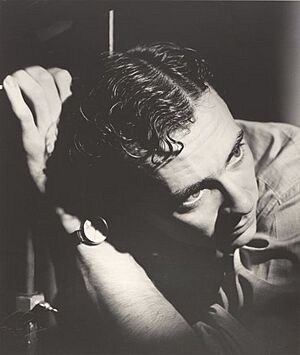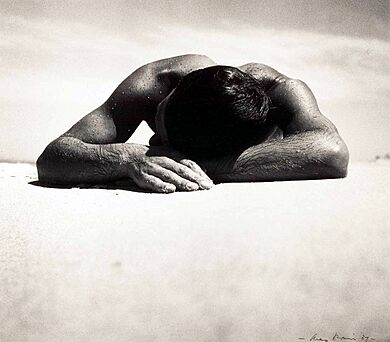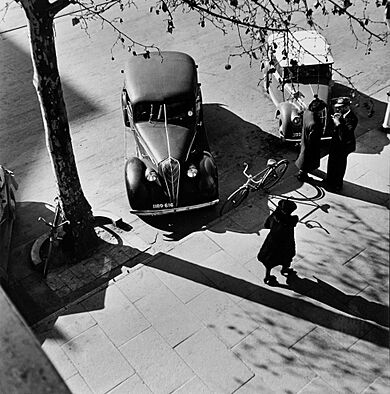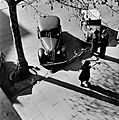Max Dupain facts for kids
Quick facts for kids
Max Dupain
AC OBE |
|
|---|---|

Dupain in 1937
|
|
| Born |
Maxwell Spencer Dupain
22 April 1911 Ashfield, New South Wales, Australia
|
| Died | 27 July 1992 (aged 81) |
| Nationality | Australian |
| Occupation | photographer |
|
Notable work
|
Sunbaker |
| Parents |
|
Maxwell Spencer Dupain (born April 22, 1911, died July 27, 1992) was a very famous Australian photographer. He was known for his modern style of photography. He received high awards for his work, including the Companion of the Order of Australia.
Contents
Early Life and Photography
Max Dupain got his first camera in 1924. This gift started his lifelong passion for photography. He joined the Photographic Society of NSW, where he learned many skills. After finishing his studies, he worked for another photographer named Cecil Bostock in Sydney.
Career Highlights
Starting His Own Studio
By 1934, Max Dupain decided to open his own photography studio. It was located on Bond Street in Sydney.
The Iconic Sunbaker
In 1937, Max Dupain was on the south coast of New South Wales. He took a photo of his English friend, Harold Salvage. Harold was lying on the sand at Culburra Beach. This photo, called Sunbaker, became very famous later on.
It wasn't until the 1970s that the photo became widely known. In 1976, the National Gallery of Australia in Canberra bought a print of it. By the 1990s, Sunbaker was seen as a truly iconic image of Australia. An early version of the Sunbaker photo is kept in an album. This album was given to the State Library of New South Wales by Dupain's friend, Chris Vandyke.
Photography During Wartime
During World War II, Dupain served in the Royal Australian Air Force. He worked in places like Darwin and Papua New Guinea. His job was to help create camouflage, which helps hide things.
The war deeply changed how Dupain saw photography. It made him want to show the truth in his pictures. He wanted his photos to be honest and real. He decided to stop taking photos that made things look "perfect" or fake. He believed photography should make people think and understand others' lives.
Focus on Reality
Dupain's photos from this time showed everyday life. One famous photo is "Meat Queue." He used a natural style, capturing real moments. He wasn't trying to make a big social statement. He just wanted to show things as they were.
Max Dupain also worked a lot for the University of New South Wales and CSR Limited. He traveled to many parts of northern Australia. He rarely left Australia, though. His first trip overseas was in 1978, when he was 67. Even then, it was to photograph the new Australian Embassy in Paris. He said he wanted to focus his photography on the place where he grew up and lived.
Architectural Photography
In the 1950s, there was a lot of new advertising. Dupain worked for magazines and companies. He also spent time on his love for architecture. He started taking photos of buildings, which he continued for most of his life.
The State Library of New South Wales has a very large collection of Max Dupain's work. In 2016, they announced they had his entire photo collection. This includes 28,000 negatives, like the Sunbaker and "Bondi, 1939." It also has photos of Penrith in Sydney from 1948. These join his other collections of commercial and architectural photos.
From 1959, Dupain often used a special camera called a Linhof Technica 4x5. It became his favorite for architectural photos until the 1980s. He used it to document the building of the Sydney Opera House from 1959 to 1973. This camera is now in the Sydney Powerhouse Museum.
Max Dupain continued to work as a photographer until he passed away in 1992.
Personal Life
In 1939, Max Dupain married Olive Cotton, who was also a photographer. They later divorced. About ten years later, Dupain married Diana Illingworth. They had a daughter named Danina and a son named Rex. Rex also became a photographer, following in his father's footsteps.
Honours and Awards
Max Dupain received several important awards for his contributions to photography:
- In 1982, he was made an Officer of the Order of the British Empire (OBE).
- In 1992, he was made a Companion of the Order of Australia (AC). This is one of Australia's highest honours.
Images for kids




